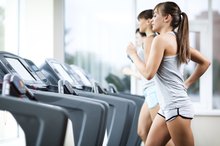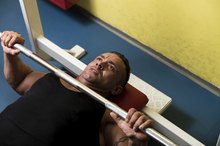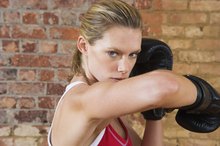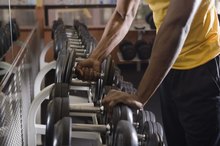Useful Exercises With Two 15-Pound Dumbbells
All you need is two 15-pound dumbbells to complete a total-body, strength-training routine. Using free weights, such as dumbbells, in lieu of bulky machines engages your stabilizing muscles in addition to the primary muscles targeted so you get a well-rounded workout. Use the weights to train your body to move naturally and skillfully in athletics and during daily activity.
Legs and Hips
Strong legs and hips keep your lower body resistant to injury and increase your stamina for daily activity and athletics. Squats and lunges are classic exercises that train this region, which includes your buttocks, or glute muscles, and your thighs, including the hamstrings and quadriceps. To do a squat with 15-pound dumbbells, stand and hold a dumbbell in each hand. Bring the weights up to your shoulders and allow your elbows to flare out as you keep the dumbbells in this position throughout the exercise. Bend your knees and and hips to lower your buttocks into a sitting position. Your back should remain straight and your thighs should come at least parallel to the floor. Extend the legs to complete one repetition. For lunges, hold a dumbbell in each hand and let them hang alongside your body. From a standing position, take a step approximately 2 feet forward with your right leg. Bend the right knee to lower your thigh toward parallel to the floor. Use your heel to press back into the standing position and do the move with your left foot to complete one repetition. If holding both weights is too much for either exercise, use your body weight only or hold just one weight in both hands in front of your chest.
Back and Chest
How To Lose Weight with Dumbbells
Learn More
Training the large muscles in your upper body creates a lean look and makes it easier to do everyday activities, from carrying groceries to throwing a ball. For your back, do rows by standing with your feet hip-distance apart and holding a dumbbell in each hand. Hinge forward from the hips at least 45 degrees and let the dumbbells hang toward the floor. Use your back muscles to pull the weights up toward your ribs, squeezing your shoulder blades together. Release the move to complete one repetition. To work your chest, lie on a workout bench with a weight in each hand. Extend your arms above your chest and bend and extend the elbows to do chest presses. You can also open the arms in an arc to do dumbbell flyes, which are a quality auxiliary move for the pectoralis major of the chest and the anterior deltoid at the front of the shoulders.
Arms and Shoulders
Biceps curls, lying triceps extensions and shoulder presses are classic dumbbell moves that work the smaller muscles of the upper body. To perform curls, stand with your feet hip-distance apart and hold a dumbbell with an underhand grip in each hand. Keep your elbows against the sides of your body as you bend your elbows to bring the weights to your shoulders. Extend your elbows to complete one repetition. Triceps extensions target the three-part muscle at the back of the upper arm. Lie on a workout bench and extend your arms to hold the weights above your chest. Keeping your upper arm in a fixed position, bend your elbows to lower the weights close to your forehead. Extend to the straight-elbow position to complete one repetition. For shoulder presses, which work the fronts and tops of the shoulders, sit on the edge of the bench and hold a dumbbell in each hand. Lift your arms to create a goal-post position with your forearms perpendicular to the floor and upper arms parallel to the floor. Press the dumbbells up to extend the elbow, then lower back to the sides of the shoulders to complete one repetition.
Increasing the Challenge
How to Correct Pulled Forward Shoulders
Learn More
If you want to increase the intensity of these exercises without getting heavier weights, you could combine some of the upper-body and lower-body moves. For example, you could lunge and do bicep curls simultaneously or squat and shoulder press. Substitute a stability ball for the bench during exercises done from a reclined or seated position to challenge your balance and make the muscles of your core work harder. Another way to create a greater challenge is to do the exercises as a circuit, meaning you do a set of each exercise in quick succession -- taking no breaks. This approach can help you burn up to 30 percent more calories, according to "Fitness" and keeps you from becoming bored.
Strategy
The Centers for Disease Control and Prevention recommends strength-training all the major muscles, including your legs, hips, back, chest, arms, shoulders and abdominals, at least two times per week with a minimum of one set of eight to 12 repetitions. To build greater strength, you can add one or more sets and/or train more often. When you do the exercises for your upper and lower body, you should feel fatigued by the 12th repetition -- if not, you may need to graduate to heavier weights or tweak the moves to build muscle. Beginners may not be able to do as many repetitions with 15 pounds and may need to seek out lighter weights until they build up enough strength. Consult a health care professional before beginning a new exercise regimen.
Related Articles
References
Writer Bio
Andrea Cespedes is a professionally trained chef who has focused studies in nutrition. With more than 20 years of experience in the fitness industry, she coaches cycling and running and teaches Pilates and yoga. She is an American Council on Exercise-certified personal trainer, RYT-200 and has degrees from Princeton and Columbia University.








